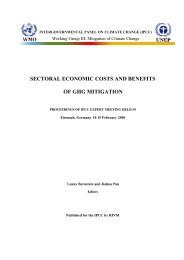Pacific Islands Environment Outlook - UNEP
Pacific Islands Environment Outlook - UNEP
Pacific Islands Environment Outlook - UNEP
Create successful ePaper yourself
Turn your PDF publications into a flip-book with our unique Google optimized e-Paper software.
52<br />
ALTERNATIVE POLICY OPTIONS<br />
The success of community-based conservation<br />
projects in the region could therefore lead logically to<br />
local improvements in food and water security and a<br />
greater degree of resilience in handling natural disasters<br />
and extreme climatic events. Such initiatives should be<br />
taken at the local/village level and could do much to<br />
offset the growing impacts of urbanization.<br />
Pollution and waste management<br />
A number of countries see this as a high priority (Fiji,<br />
Niue, Samoa and the USP raised this at the Regional<br />
Workshop) and it has already been discussed, together<br />
with the link to urbanization, in Chapter One. The<br />
reversal of present trends will call for a concentrated<br />
effort to build capacity across the region, backed by a<br />
menu of policy options that will reduce the volume of<br />
conventional waste streams (both solid and liquid).<br />
Attention also needs to be given to new and unfamiliar<br />
forms of waste, such as packaging material that is hard<br />
to dispose of, or the by-products of new technology.<br />
The three Rs of waste management – reduce, reuse<br />
and recycle – cannot be fully applied in the<br />
circumstances of most PICs. The size of the market is<br />
too small to impose special packaging requirements on a<br />
distant exporter, and this also affects the economic<br />
opportunities for recovering waste materials or recycling<br />
them. The region is thus at the end of the line for many<br />
waste streams generated in manufacturing countries, and<br />
special measures (e.g. surcharges, taxes or deposits) may<br />
be justified for plastics, cans and bottles. Such<br />
instruments are fully in line with the Polluter Pays<br />
Principle. The funding thus obtained could be used in<br />
part to ensure that these materials can be sorted and<br />
back-loaded at reduced rates to destinations where<br />
recycling can be carried out.<br />
There are other areas where a ‘clean <strong>Pacific</strong>’ policy<br />
may be justified, given the limited space for waste<br />
disposal facilities on many islands and the huge<br />
exposure of coastal regions to intractable waste, such<br />
as polystyrene and plastic bags. It is here that the link<br />
is most obvious with the need for clean water and food<br />
security. Public education and awareness will need to<br />
be built up, using vernacular material – as has been<br />
shown in some of the region-wide campaigns on<br />
conservation issues.<br />
The composition of the waste stream will respond<br />
both to rising levels of consumption and to shifts in<br />
production patterns in exporting countries. The<br />
example of building materials is a case in point.<br />
Increased proportions of treated timber and plastic<br />
composites mean that building wastes, particularly<br />
from commercial buildings, hotels and larger public<br />
institutions (e.g. schools, hospitals), will become less<br />
easy to dispose of. This is an area where awareness can<br />
be developed within the industry and where standards<br />
can be used as appropriate. Demonstration projects<br />
using an adaptation of traditional building techniques,<br />
using local materials where available, would assist in<br />
the process.<br />
Regional action is needed in some of the more<br />
specialized areas of waste management: information<br />
networks can be developed on the identification and<br />
handling of hazardous wastes and toxic materials, and<br />
guidelines can be drawn up for improved environmental<br />
management in ports and harbours and for the<br />
protection of freshwater lenses. Other actions will be<br />
primarily local in nature: examples include the<br />
construction of siltation controls, planting to assist<br />
filtration and protect water bodies, and sorting of waste<br />
streams at village/neighbourhood level.<br />
In relation to this, an important policy issue<br />
confronting governments and regional agencies is<br />
whether the region can expect to influence the choice<br />
of technology in a direction that improves the health<br />
and welfare of <strong>Pacific</strong> peoples. This could be achieved,<br />
for example, if a technology is introduced which<br />
reduces the present high levels of risk and vulnerability<br />
to which the region is exposed. <strong>Environment</strong>al opinion<br />
tends to regard technology as a two-edged sword: it<br />
promises lower throughput of resources and reduced<br />
pollution, but it also removes us further from any direct<br />
connection with natural cycles and the resources on<br />
which we ultimately depend for survival.<br />
Integrated decision-making<br />
To make progress with water security and waste<br />
management issues it will be important to develop<br />
effective ways of integrating environmental<br />
considerations within decision-making. Since the Earth<br />
Summit in 1992 there has been a theoretical acceptance<br />
of the need to integrate environment and economics.<br />
Examples of such integration taking place in PICs are<br />
outlined in Chapter Two. The extent, however, to which<br />
this has gone beyond co-ordination through committee<br />
structures and consultative process is unclear.<br />
The logic of integrating environment and economics<br />
leads to the conclusion that it is the development<br />
agency (Finance, Planning, Development or Treasury)

















